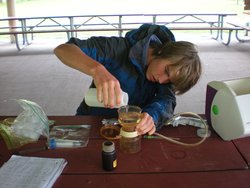2010 Algae Monitoring Results

An LCC blue green algae monitor taking a sample at Burlington’s North Beach. Photo by Lori Fisher (http://www.lakechamplaincommittee.org/lcc-at-work/algae-in-lake/).
Results from the Lake Champlain Committee's volunteer water monitoring program provide insight into the levels and locations of nutrient pollution. In 2010, significant algae blooms developed early during a July heat wave. Evidence of the bloom was reported from Burlington south to Port Henry, areas not usually associated with bloom conditions. These blooms cleared by mid-July. St. Albans Bay developed a bloom that persisted through much of July and into August. Blooms in Missisquoi Bay were less severe than in recent years and for the first time since 2007 no ‘high alerts’ (worrisome levels of actual toxins measured) were issued.
LCC’s program has been in place since the summer of 2004 when we began our partnership with the University of Vermont Rubenstein Lab, to expand <link get-involved volunteers bga-monitors>blue green algae monitoring on Lake Champlain. LCC helps train and oversee citizen monitors who take weekly water samples from select shoreline areas. We also monitor several shoreline beaches, do visual site checks at additional locations, and serve as a first responder when blooms are underway. This program, which LCC initiated, provides critical data on where and when blooms are happening. The information we gather is used by public health officials to assess whether the water is safe for swimming. Many thanks to our dedicated monitors for checking sites weekly and to the Lake Champlain Basin Program for funding the program.
Comparison with recent years
Year | # of Samples | low alerts | high alerts |
2010 | 187 | 17 | 0 |
2009 | 184 | 19 | 3 |
2008 | 172 | 21 | 3 |
2007 | 153 | 6 | 0 |
2006 | 149 | 48 | 3 |
2005 | 93 | 23 | 3 |
